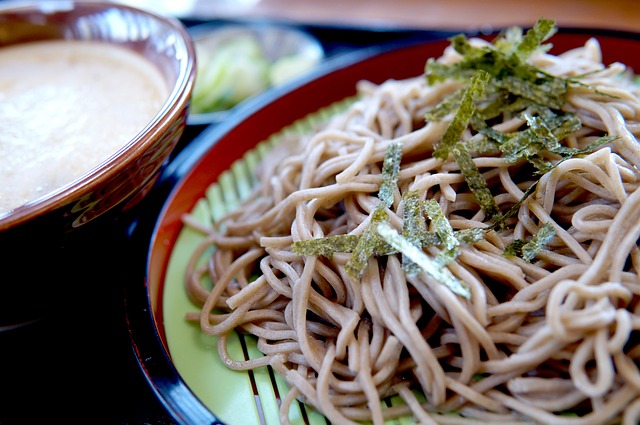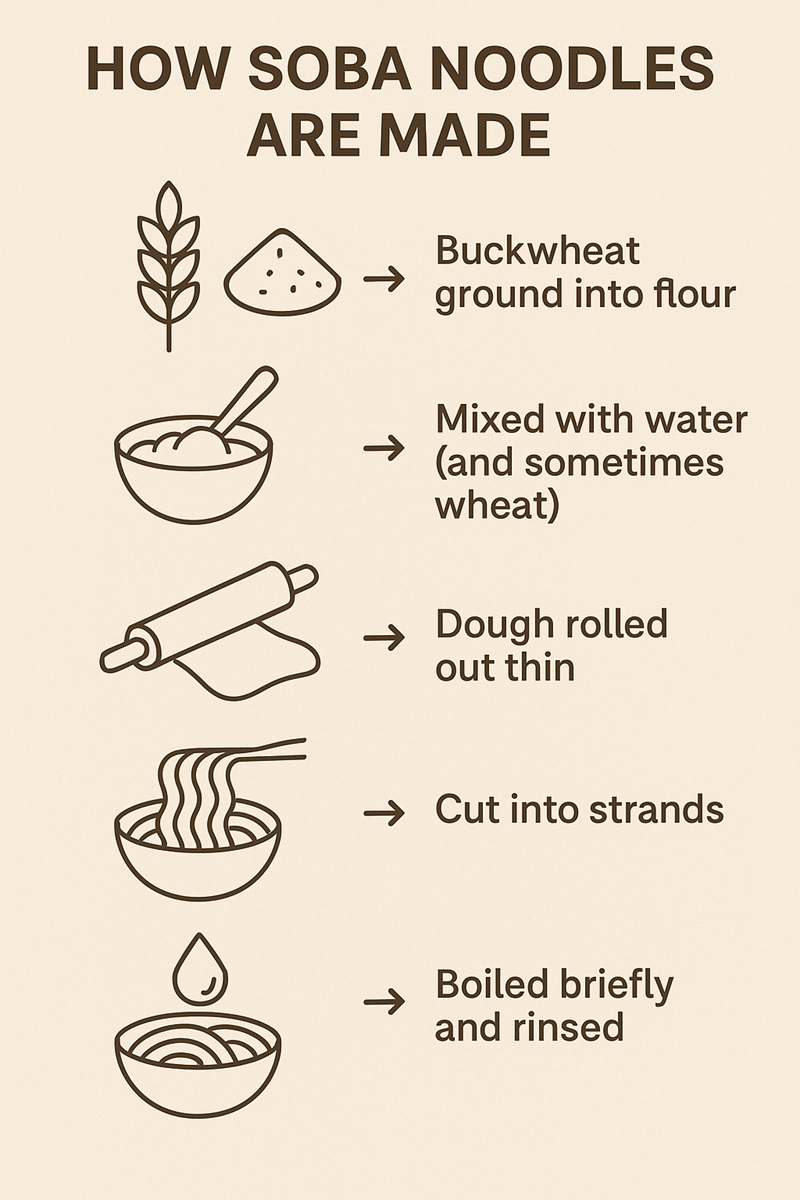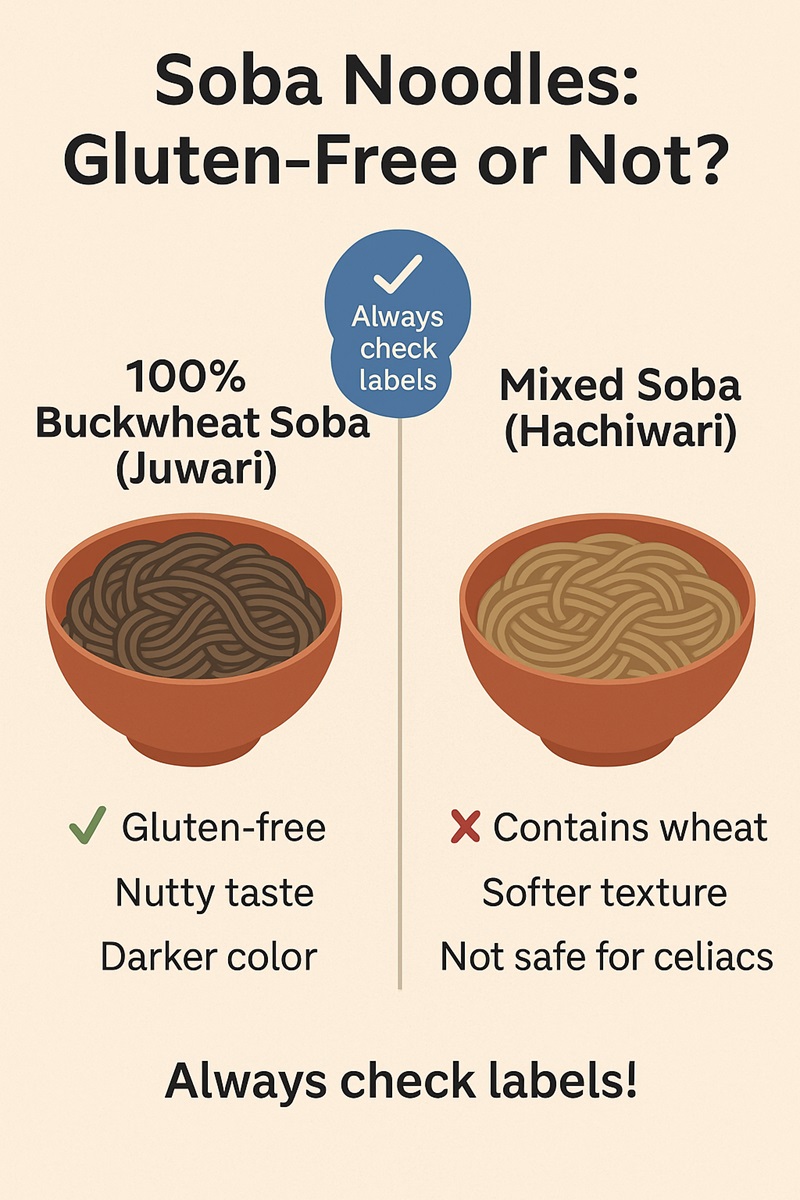Soba noodles are a popular choice for people who want a healthy swap for pasta or ramen. But if you’re gluten-sensitive, you may ask: Are soba noodles gluten-free? And beyond gluten, how do they compare for protein, calories, and health perks?
Here’s a clear guide — from gluten facts to nutrition and safe ways to enjoy soba.
What Are Soba Noodles?
Soba noodles come from Japan and are made with buckwheat flour. Even though “wheat” is in the name, buckwheat is not wheat at all. It’s a gluten-free seed packed with nutrients.
The catch? Many soba brands in U.S. stores mix wheat flour with buckwheat. This makes the noodles smoother and less fragile — but it also adds gluten. That’s why people with gluten concerns must check the label.
Soba Noodle Types
- 100% Buckwheat Soba (Juwari Soba):
Made only with buckwheat and water. Nutty taste, darker color, gluten-free. - Mixed Soba (Hachiwari Soba):
About 80% buckwheat and 20% wheat flour. Softer texture but not gluten-free.
How Soba Noodles Are Made
- Buckwheat (and wheat, if used) is ground into flour.
- Water is mixed in to form a dough.
- Dough is rolled thin and cut into strands.
- Noodles are boiled for a few minutes, then rinsed in cold water to set texture.
In Japan, soba is often handmade. In the U.S., most soba is machine-made and sold as dried noodles.
Are Soba Noodles Gluten-Free?
Here’s the truth:
- Yes, if they are made with 100% buckwheat flour. Pure buckwheat soba is naturally gluten-free.
- No, if they are blended with wheat flour. Many soba noodles contain a mix of buckwheat and wheat, which means they’re unsafe for people with celiac disease or gluten intolerance.
- Always read the label. Look for packaging that clearly states “100% buckwheat” or carries a certified gluten-free logo.
Dining Out Tip: At restaurants, soba noodles may be cooked in the same water as wheat-based noodles, leading to cross-contamination. If you’re celiac, ask before ordering.
Soba Noodles Nutrition Facts
When you choose 100% buckwheat soba, you’re not just getting gluten-free noodles — you’re also tapping into a solid nutrient profile.
Nutrition per 100g cooked soba noodles (approximate):
- Calories: ~99
- Carbohydrates: ~21g
- Protein: ~5g
- Fiber: ~2g
- Fat: <1g
- Key micronutrients: Manganese, thiamine (B1), magnesium, phosphorus
How Soba Compares to Other Noodles
Wondering how soba stacks up against pasta, rice noodles, or ramen? Here’s a simple breakdown:
| Feature | Soba Noodles (100% Buckwheat) | White Pasta | Rice Noodles | Ramen Noodles |
| Calories (per cup, cooked) | ~99 | ~130–150 | ~190 | ~188–220 (often fried) |
| Carbohydrates | ~21g | ~25–30g | ~44g | ~27–30g |
| Protein | ~5g | ~4–5g | ~3g | ~4–5g |
| Fiber | ~2g | ~1–2g | <1g | ~1–2g |
| Glycemic Index (GI) | Low GI (slower blood sugar rise) | Moderate GI | Higher GI | High GI (refined wheat) |
| Micronutrients | Rich in manganese, magnesium, phosphorus, rutin | Limited unless fortified | Lower in minerals | Very low nutrients; high sodium (instant ramen) |
| Takeaway | Lean, protein-rich, nutrient-dense; gluten-free if 100% buckwheat | Common but less fiber & nutrients | Higher carb load, less protein & minerals | Least healthy: refined wheat, fried, high sodium |
Among these, soba is one of the best choices. It gives steady energy, more nutrients, and better balance than other popular noodles.
Protein in Soba Noodles: Why It Matters
Protein is where soba noodles stand out compared to other noodle varieties. Buckwheat contains all nine essential amino acids, making it a high-quality plant-based protein.
- Great for vegetarians and vegans: A hearty protein source that’s gluten-free.
- Higher satiety: Protein + fiber combination helps you feel fuller for longer.
- Supports muscle repair and energy: Especially useful for active individuals.
Health Benefits of Soba Noodles
Soba noodles do more than taste good. They also give your body real health perks:
1. Weight Management
Soba noodles have fewer calories than many pastas. They also have more fiber. Fiber makes you feel full and helps stop overeating. Swapping regular pasta with soba may help with weight loss or control while still keeping meals tasty.
2. Blood Sugar Control
Soba noodles have a low glycemic index (GI). This means they don’t raise blood sugar as fast as white pasta or bread. Energy from soba comes slowly, helping people with type 2 diabetes or prediabetes. It also helps anyone avoid energy crashes.
3. Heart Health
Buckwheat, the main ingredient in soba, has a compound called rutin. Rutin helps blood flow and strengthens blood vessels. Fiber in soba also helps lower bad cholesterol (LDL). Eating soba instead of refined carbs can support heart health.
4. Gut Health
Soba noodles give your body fiber, which feeds good gut bacteria. Fiber also helps you stay regular and improves digestion. While soba is not the highest-fiber food, it adds balance when eaten with vegetables, beans, and other fiber-rich foods.
5. Gluten-Free Living
100% buckwheat soba is gluten-free. This makes it safe for people with celiac disease or gluten sensitivity. It’s a tasty option for noodle soups, stir-fries, or cold dishes without causing stomach issues.
How to Add Soba Noodles to a Healthy Diet
Soba noodles are easy to use in many meals. They fit well into a balanced diet.
Add lean protein like chicken, shrimp, tofu, or edamame. This makes the dish more filling and adds extra nutrition.
Mix soba with vegetables such as broccoli, spinach, carrots, mushrooms, or bok choy. These add fiber, vitamins, and minerals.
If making soba in broth, choose low-sodium soy sauce or miso to keep it heart-healthy.
Here are some tasty ways to enjoy soba:
- Cold Sesame Soba Salad: Toss noodles with cucumbers, carrots, and sesame oil.
- Miso Soba Soup: A warm bowl with tofu, scallions, and mushrooms.
- Stir-Fried Soba: Cook with garlic, ginger, greens, and lean protein.
Swap soba for pasta or rice. You’ll get more protein and fiber in every bite.
How to Choose and Cook Gluten-Free Soba Noodles
- Check the Label: Look for “100% buckwheat” or a gluten-free certification.
- Popular USA Gluten-Free Brands: King Soba, Eden Foods, Hakubaku (gluten-free lines).
- Cooking Tip: Soba can become mushy if overcooked. Boil gently for 4–6 minutes, then rinse under cold water to stop cooking.
- Healthy Serving Ideas:
- Cold soba salad with sesame and veggies
- Warm miso soba soup
- Stir-fried soba with tofu and greens
FAQs About Soba Noodles and Gluten
Q: Are soba noodles safe for people with celiac disease?
✅ Yes, but only if they are labeled 100% buckwheat or certified gluten-free.
Q: Do soba noodles taste different from pasta?
Yes. They have a nutty, earthy flavor compared to the neutral taste of wheat pasta.
Q: Can soba noodles help with weight loss?
They can — thanks to lower calories, higher protein, and fiber content.
Q: Are soba noodles healthier than ramen?
Absolutely. Ramen is usually made from refined wheat flour and often fried, while soba offers more nutrients and a lower glycemic load.
Conclusion
So, are soba noodles gluten-free? It depends on the kind you buy. 100% buckwheat soba is gluten-free, while soba mixed with wheat is not safe for people who can’t eat gluten.
Soba noodles are more than a food trend. They offer protein, fiber, and a low glycemic index. These traits support weight control, steady blood sugar, and heart health.
When shopping, look for gluten-free labels. Then enjoy soba in soups, salads, or stir-fries as a tasty and healthy choice.






